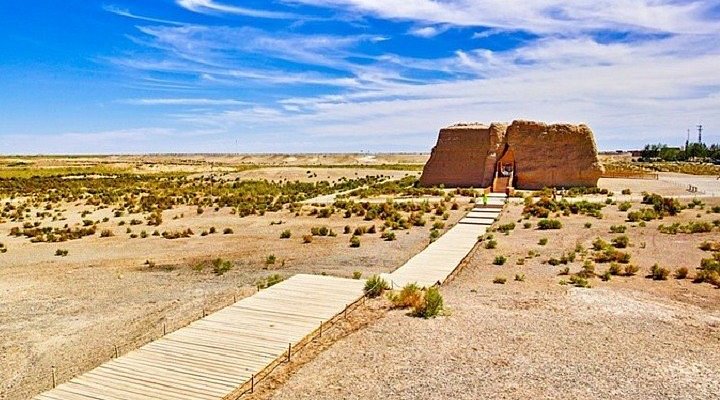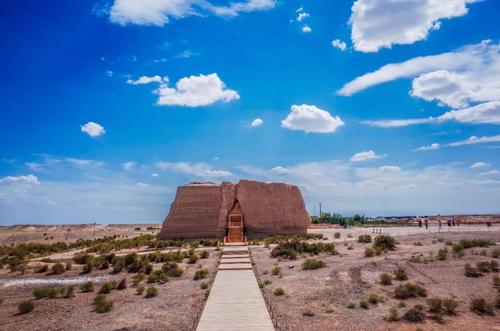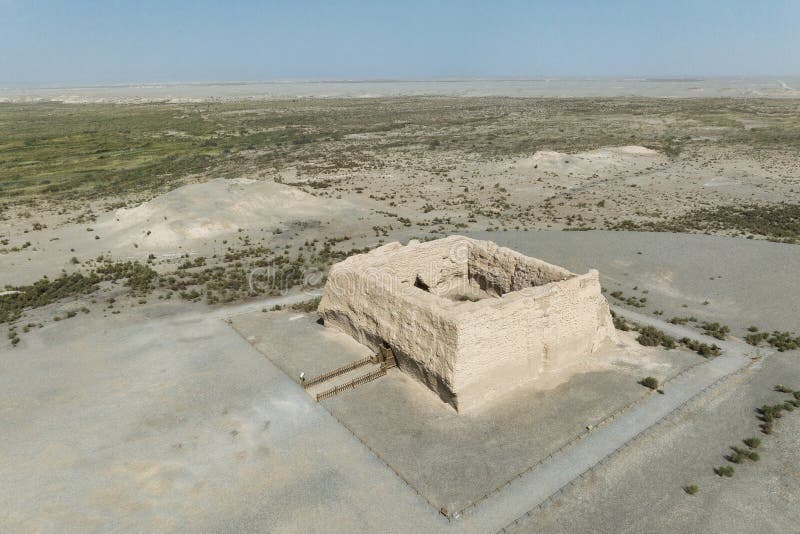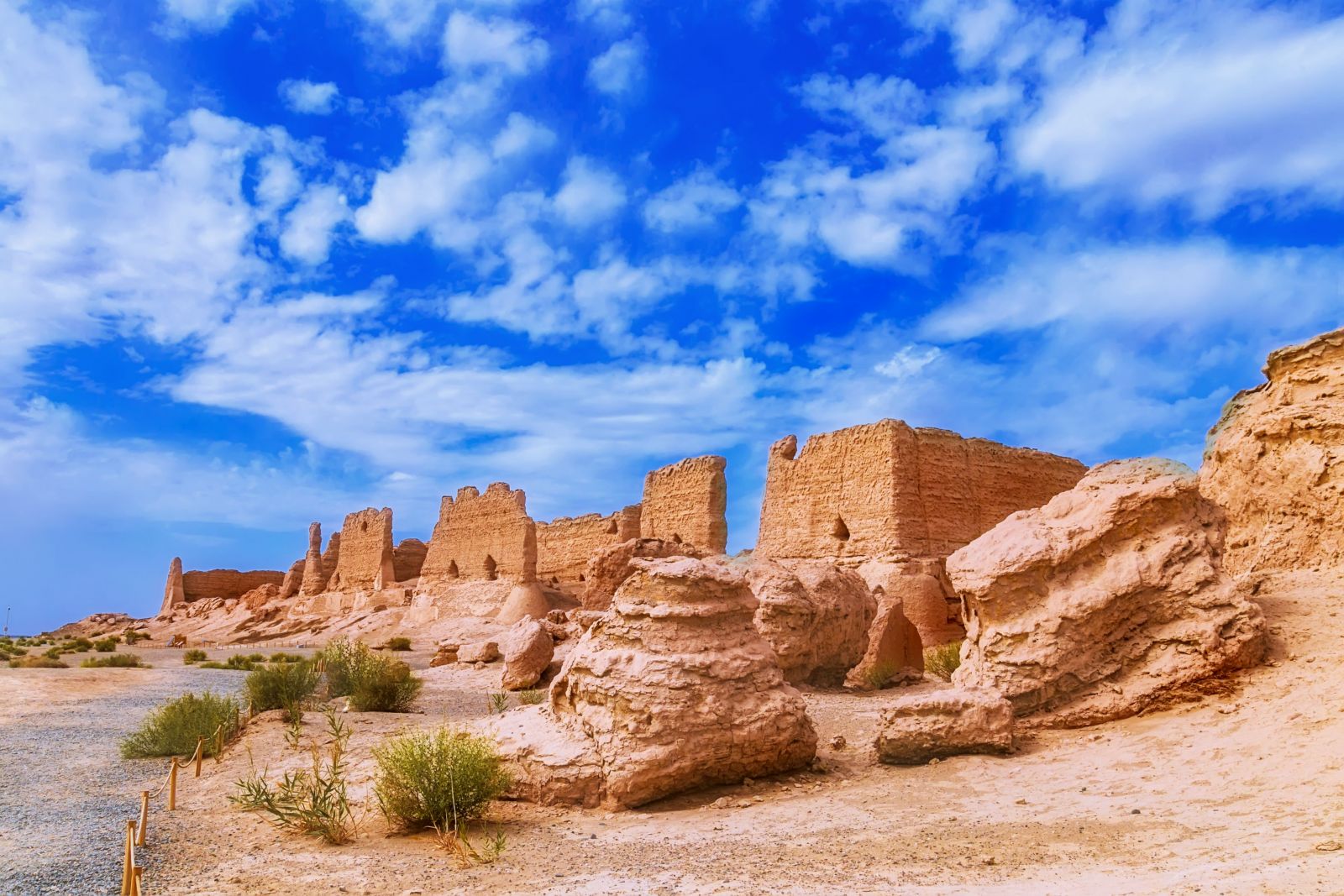Unveiling Yumen Pass: Your Ultimate Travel Guide

An Essential Guide to Visiting Yumen Pass
Nestled in the heart of the Gobi Desert, Yumen Pass, also known as the Jade Gate, stands as a remarkable testament to the storied past of the ancient Silk Road. This historical checkpoint, which dates back over 2,000 years, once served as a vital gateway, connecting the flourishing civilizations of the East with the mysterious lands to the West. As you approach this iconic landmark, you can almost hear the echoes of bustling caravans and the whispers of merchants who traversed this arid landscape in search of fortune and opportunity.
Visiting Yumen Pass is not just a journey through time; it’s an immersive experience that allows you to walk in the footsteps of history. With remnants of fortifications, a nearby museum, and breathtaking desert vistas, this site invites travelers to explore the remnants of a once-thriving outpost that played a pivotal role in trade and cultural exchange. Whether you are a history enthusiast, an avid photographer, or simply in search of adventure, Yumen Pass promises a captivating glimpse into the ancient world and the enduring spirit of the Silk Road.
Prepare to be enchanted by the stark beauty of the surrounding landscape, where the remnants of the Han Great Wall and the vast, open sky create a stunning backdrop. As you wander through this living museum, take a moment to reflect on the significance of Yumen Pass—an enduring symbol of connection and discovery that continues to inspire wanderers to this day.
In This Guide
- An Essential Guide to Visiting Yumen Pass
- The Rich History and Legends of Yumen Pass
- Main Highlights: What You Absolutely Can’t Miss
- Planning Your Visit: A Practical Guide
- Tickets: Prices, Booking, and Tips
- How to Get There: A Complete Transportation Guide
- Local Cuisine and Accommodation Nearby
- Frequently Asked Questions
- Final Thoughts on Your Trip
The Rich History and Legends of Yumen Pass
Nestled in the arid expanses of Gansu Province, Yumen Pass (玉门关) stands as a testament to the rich tapestry of history woven through the Silk Road. This ancient fortification, known also as the Jade Gate, was established during the Han Dynasty around 121 BC. It served as a critical checkpoint that marked the edge of the Chinese empire, acting as a gateway for caravans traveling westward towards Central Asia and beyond.
The significance of Yumen Pass transcends its geographical location; it was a bustling hub of trade and cultural exchange. Merchants, pilgrims, and adventurers passed through this gate, bringing with them goods, ideas, and stories from distant lands. The pass was strategically positioned near the ancient Great Wall, which extended its protective reach into the arid deserts of the Gobi. Although much of the wall has crumbled over time, remnants of its fortifications still evoke a sense of the grandeur that once characterized this vital trade route.
Legends abound regarding Yumen Pass. It is said that during the height of the Silk Road’s activity, the area was alive with the sounds of commerce and the scents of exotic spices. Poets from the Tang Dynasty immortalized the pass in their verses, capturing the spirit of adventure and longing that defined the journeys of those who traversed this arid landscape. The imagery of Yumen Pass often conjures feelings of nostalgia, reflecting both the beauty and the hardships faced by travelers in search of prosperity and enlightenment.
Today, visitors to Yumen Pass can explore the remnants of its storied past. The site features a museum that provides insights into the history of the pass and its role in the Silk Road. An audio guide enhances the experience, allowing travelers to immerse themselves in the tales of ancient caravans and the challenges they faced against the backdrop of the vast desert. The surrounding landscape, characterized by stark beauty and a sense of isolation, invites contemplation of the lives that once thrived here.
While the physical structures may have diminished over the centuries, the legacy of Yumen Pass endures. It remains a symbol of the enduring human spirit—a reminder of the connections forged between diverse cultures and the shared history that continues to inspire wanderers from around the globe. Whether you are a history buff or simply seeking a profound connection to the past, Yumen Pass offers an unforgettable journey through time.

Yumen Pass.
Main Highlights: What You Absolutely Can’t Miss
Main Highlights at Yumen Pass (玉门关)
Visiting Yumen Pass is like stepping back in time to the era of the Han Dynasty, a crucial checkpoint along the ancient Silk Road. This historic site, also known as the Jade Gate, offers visitors a unique blend of breathtaking landscapes, rich history, and the remnants of a once-thriving trading post. Here are the highlights you absolutely can’t miss during your visit to this remarkable locale.
1. The Yumen Gate
The iconic Yumen Gate is the centerpiece of the site and serves as a poignant reminder of China’s ancient trade routes. Originally built around 121 BC, this gate was once a bustling entry point for caravans journeying between the East and West. Standing before this ancient structure, you can almost hear the echoes of merchants, travelers, and soldiers who passed through centuries ago. The gate is easily accessible from the main museum, making it a must-visit spot.
2. The Han Great Wall Ruins
Just a short bus ride away, the remnants of the Han Great Wall stretch across the arid landscape, showcasing the engineering prowess of ancient China. These ruins, built to protect trade routes and the empire from invasions, offer a fascinating glimpse into history. As you walk along the wall, take a moment to appreciate how far it extends and the strategic significance it held over two millennia ago.
3. The Museum
Before exploring the outdoor sites, make sure to visit the on-site museum. It houses informative exhibits detailing the history of Yumen Pass and the Silk Road. The museum provides excellent context for what you will see outside, featuring artifacts and displays that highlight the cultural exchanges that took place here. For an enhanced experience, consider renting the audio guide available in multiple languages, which will enrich your understanding of the historical significance of each site.
4. The Vast Desert Scenery
One of the highlights of visiting Yumen Pass is the stunning desert scenery that surrounds you. The stark beauty of the Gobi Desert, with its vast open skies and rugged landscapes, creates a captivating backdrop for your exploration. Whether you’re walking along the remnants of the Great Wall or standing at the Yumen Gate, the scenery offers perfect opportunities for photography and reflection.
5. Historical Significance
As you explore Yumen Pass, take a moment to contemplate its role as a critical checkpoint in the Silk Road trade network. This site was not just a physical barrier but also a cultural crossroads where goods, ideas, and traditions flowed between civilizations. For history buffs, imagining the lively exchanges that took place here adds an enriching layer to your visit.
6. Sunset Views
If possible, linger until sunset to witness the breathtaking colors that wash over the desert landscape. The golden hues against the backdrop of ancient ruins create an unforgettable scene, perfect for capturing that perfect Instagram shot or simply soaking in the tranquil atmosphere.
7. Guided Tours
For those seeking a more in-depth exploration, consider joining one of the guided tours available. These tours often include transportation and provide insightful commentary on the historical significance of Yumen Pass and its surroundings. Check local listings for options that fit your schedule and interests.
Conclusion
Your visit to Yumen Pass is not just about seeing ancient ruins; it’s about experiencing a slice of history that shaped the cultures and economies of generations. From the impressive Yumen Gate to the remnants of the Han Great Wall, this historic site offers a profound connection to the past, making it an essential stop on your Silk Road adventure. Don’t forget your camera and an open mind to truly appreciate the wonders of this ancient gateway!

Yumen Pass.
Planning Your Visit: A Practical Guide
Visiting Yumen Pass (玉门关) offers a unique glimpse into the rich history of the Silk Road, where ancient caravans once journeyed through this vital gateway into China. As you plan your adventure, here are essential tips and information to ensure you make the most of your visit.
Getting There
Yumen Pass is located approximately 90 kilometers northwest of Dunhuang, making it accessible by car or bus. Expect about a one-hour journey from the city center. If you’re driving, the route is straightforward, but if you’re using public transport, local tours often include transportation as part of their packages.
Best Time to Visit
The pass is open year-round from 8:00 AM to 6:00 PM, providing ample opportunity for exploration. However, the best times to visit are during the spring (April to June) and autumn (September to October) months when the weather is mild and pleasant. Summer can be quite hot, while winters can be chilly, especially in the Gobi Desert.
Admission and Tours
- Entrance Fee: The entry fee to the site is approximately 40 Yuan. Be prepared to purchase a separate bus ticket if you plan to visit the various locations around Yumen Pass.
- Audio Guide: Consider renting the audio guide available in multiple languages for around 40 Yuan. It enhances the experience by providing historical context as you explore the ruins and fortifications.
- Tours: Several tour options are available, ranging from private day tours to multi-day packages that may include other nearby attractions like the Mogao Caves and Crescent Moon Pool. Options start at $200 and can go up to $2,199 for comprehensive tours.
Exploring the Site
Yumen Pass encompasses several key areas:
– The Gate: The main attraction is the Yumen Gate itself, a short walk from the museum. Here, you can envision the once-bustling trade route that defined ancient commerce.
– Han Great Wall Ruins: Accessible via the bus service, these remnants of the ancient wall showcase the strategic importance of the pass.
– Museum: The on-site museum provides valuable insights into the history of the Silk Road and the significance of Yumen Pass. It features exhibits that detail the passage’s role in trade and cultural exchange.
What to Expect
While the site may not boast extravagant structures, the vastness of the surrounding landscape and the remnants of fortifications offer a poignant reminder of its historical significance. Expect to spend around 2 to 3 hours exploring the main sites, soaking in the history and enjoying the serene desert environment.
Tips for Your Visit
- Dress Appropriately: Wear comfortable shoes and dress in layers, especially if visiting during the cooler months. The desert climate can change quickly.
- Stay Hydrated: Bring water, as facilities may be limited, especially in remote areas.
- Photography: The desolate beauty of the landscape makes for excellent photography opportunities, so don’t forget your camera!
- Language Barrier: While some staff may speak English, it’s advisable to have a translation app or phrasebook handy for smoother communication.
- Timing: Aim to arrive early in the day to avoid crowds, especially during peak tourist seasons.
Nearby Attractions
Consider extending your visit to include nearby attractions such as:
– Yadan National Geological Park: A stunning landscape of unique rock formations located close by.
– Crescent Moon Pool: A serene oasis amidst the desert, perfect for a picturesque stop.
With its rich history and stunning desert scenery, Yumen Pass promises an unforgettable experience for international travelers looking to explore one of China’s historical treasures. Prepare for a journey through time as you walk in the footsteps of ancient traders and discover the stories that lie within this remarkable landscape.

Yumen Pass.
Tickets: Prices, Booking, and Tips
When planning your visit to Yumen Pass, also known as Jade Gate Pass, it’s essential to be well-informed about ticket prices, booking options, and handy tips to make the most of your experience.
Ticket Prices
The entrance fee for Yumen Pass is approximately ¥40 (about $5.50 USD). This ticket grants you access to the main site, including the audio guide, which is highly recommended for a more enriching experience. The audio guide costs an additional ¥40, and it features GPS functionality to provide context as you explore the area.
Booking Options
While you can purchase tickets directly at the entrance, it’s advisable to consider booking a guided tour, especially for international travelers. Many local tour operators offer packages that include transportation from Dunhuang, which is about an hour away, and visits to nearby attractions like the Mogao Caves and Yangguan Pass. Options range from short half-day tours to comprehensive multi-day itineraries, with prices starting from around ¥298 ($40 USD) for a day tour. Booking in advance can often provide better rates and ensure availability during peak tourist seasons.
Transportation
To reach Yumen Pass, you can either drive or take a bus from Dunhuang. If you opt for the bus, note that tickets for the bus service are sold separately. The bus operates every 30 minutes, taking visitors to three key sites, including the gate itself, with roughly 20 minutes allocated at each location. Be prepared for some logistical details; for instance, it’s a good idea to confirm your bus ticket purchase before boarding.
Tips for a Great Visit
-
Timing Your Visit: Yumen Pass is open daily from 8:00 AM to 6:00 PM, making it easy to fit into your travel itinerary. Early morning visits can help you avoid crowds and enjoy cooler temperatures, especially during the summer months.
-
Audio Guide: Invest in the audio guide for a deeper understanding of the historical significance of the site. User reviews suggest that it greatly enhances the visit, providing insights into the ancient Silk Road and the Han dynasty.
-
Dress Comfortably: The environment can be quite arid, so wear comfortable clothing and sturdy shoes. Sunscreen and a hat are also advisable, as the sun can be intense, especially during midday.
-
Explore Nearby Attractions: Consider combining your trip to Yumen Pass with visits to other local sites like Yadan National Geological Park, which can provide a fuller experience of the region’s natural beauty and history.
-
Stay Hydrated: Given the desert climate, ensure you carry enough water to stay hydrated during your explorations.
With the right preparation, your visit to Yumen Pass will be a rewarding journey through history, offering a glimpse into the ancient trade routes that shaped cultural exchanges across centuries.
How to Get There: A Complete Transportation Guide
Reaching the Yumen Pass (玉门关), a historical gem along the ancient Silk Road, is an adventure that combines scenic landscapes and cultural exploration. Here’s your comprehensive guide to navigating this remote yet fascinating destination from Dunhuang, the nearest city.
Getting to Dunhuang
By Air:
Dunhuang has a small airport (Dunhuang Mogao Airport) that connects with major cities in China. Flights from Beijing, Xi’an, and Lanzhou are available. Upon arrival, you can take a taxi or a shuttle to the city center.
By Train:
Dunhuang is also accessible by train, with services from cities like Zhangye and Jiayuguan. The train station is a short taxi ride from the city center.
By Bus:
Long-distance buses operate to and from Dunhuang, connecting it with regions across Gansu province. Ensure to check the schedule in advance, as it may vary.
From Dunhuang to Yumen Pass
Once you’re in Dunhuang, getting to Yumen Pass is straightforward:
By Private Tour:
One of the most convenient options is to book a private tour. Many local agencies offer packages that include transportation, guided tours, and entry tickets to the pass. This is a great choice for those who want a hassle-free experience and comprehensive insights into the historical significance of the area.
By Taxi:
You can hire a taxi for a direct trip to Yumen Pass, which is approximately 90 kilometers (about 56 miles) northwest of Dunhuang. The ride takes around one hour, and you can negotiate a round-trip fare with the driver if you prefer.
By Bus:
For budget travelers, there are local buses that run from Dunhuang to Yumen Pass. You will need to purchase a bus ticket separately from your entry ticket to the pass. Buses typically depart every 30 minutes, and the journey takes about 1.5 hours. The bus will take you to key sites, including the gate itself and the nearby Han Great Wall ruins.
Tips for Visiting
-
Audio Guides: Consider renting an audio guide at the entrance for a richer understanding of the site’s historical context. It’s available in English and enhances the experience significantly.
-
Timing Your Visit: The Yumen Pass is open from 8:00 AM to 6:00 PM. Arriving early allows you to beat the crowds and enjoy the vast desert landscapes in the cooler morning air.
-
Plan Your Stops: The bus service to Yumen Pass includes multiple stops, allowing you to explore various historical sites. Allocate approximately 2-3 hours to fully appreciate the area.
-
Language Barrier: While staff at the site may not speak English fluently, they are generally helpful. It may be beneficial to have a translation app on hand to facilitate communication.
Conclusion
Visiting the Yumen Pass is not just a journey through time but also an exploration of the stunning landscapes of the Gobi Desert. With various transportation options available from Dunhuang, you can easily tailor your trip to fit your preferences and budget. Whether you choose a private tour, a taxi, or the local bus, the Yumen Pass awaits to unveil its ancient secrets and breathtaking views.

Yumen Pass.
Local Cuisine and Accommodation Nearby
When exploring the historical wonders of Yumen Pass, it’s essential to fuel your adventure with delicious local cuisine and find comfortable accommodations nearby. The region around Dunhuang offers unique dining experiences and a variety of places to stay, making it a memorable stop on your Silk Road journey.
Local Cuisine
Dunhuang Noodles
A must-try dish is Dunhuang noodles, known for their chewy texture and rich flavors. Often served with savory beef or lamb broth, these noodles are a favorite among both locals and travelers. Look for small eateries or noodle shops in Dunhuang to enjoy an authentic bowl.
Roasted Lamb Skewers
As you stroll through the bustling streets of Dunhuang, you’ll encounter stalls serving roasted lamb skewers, seasoned to perfection. This popular street food is not only flavorful but also a great way to experience the local culture. Pair it with some fresh vegetables or a side of flatbread for a filling meal.
Mogao Grottoes Tea
After a day of exploring, indulge in a cup of tea inspired by the ancient Mogao Grottoes. Local tea houses offer a selection of herbal and floral infusions that reflect the region’s natural beauty. Enjoying tea in a historic setting adds a special touch to your culinary experience.
Accommodation Nearby
Dunhuang Silk Road Hotel
For a comfortable stay, consider the Dunhuang Silk Road Hotel. This well-rated hotel provides modern amenities and is conveniently located close to the city’s attractions, including Yumen Pass. Guests can enjoy spacious rooms, a restaurant featuring local dishes, and a relaxing atmosphere after a day of exploration.
Dunhuang Grand Hotel
Another excellent option is the Dunhuang Grand Hotel, known for its luxurious accommodations and exceptional service. With beautifully appointed rooms and a restaurant that serves both local and international cuisines, it’s a perfect base for your Silk Road adventures. The hotel also offers guided tours, making it easy to plan your visits.
Hostels and Guesthouses
For travelers on a budget, Dunhuang offers several hostels and guesthouses that provide a cozy atmosphere and the chance to meet fellow adventurers. Look for places with a communal kitchen, allowing you to try cooking some local dishes yourself, or engage in cultural exchanges with other guests.
Whether you’re savoring the flavors of Dunhuang or unwinding in comfortable lodgings, the area surrounding Yumen Pass provides a rich tapestry of experiences that enhance your journey along this historic route.

Yumen Pass.
Frequently Asked Questions
Frequently Asked Questions about Yumen Pass (玉门关)
-
What are the opening hours for Yumen Pass?
Yumen Pass is open daily from 8:00 AM to 6:00 PM. It’s a good idea to visit early to avoid crowds and enjoy the serenity of the ancient site. -
How do I get to Yumen Pass from Dunhuang?
Yumen Pass is located approximately 90 kilometers northwest of Dunhuang. You can take a taxi or join a guided tour, which often includes transportation. Public buses may also be available, but they might not be as convenient. -
Is there an admission fee?
Yes, there is an entrance fee to visit Yumen Pass. Additionally, if you wish to explore further sites like the Han Great Wall and remnants of ancient fortifications, you may need to purchase a separate bus ticket. -
Are there guided tours available?
Absolutely! Many tour operators offer guided tours that include Yumen Pass, often combined with other nearby attractions. Options range from private tours to group excursions, providing a variety of experiences tailored to different interests. -
What facilities are available on-site?
The site features a museum that provides historical context about Yumen Pass and its significance along the Silk Road. An audio guide is also available in multiple languages, enhancing your visit with informative insights. -
How long should I plan to spend at Yumen Pass?
A visit typically takes about 2 to 3 hours, allowing you to explore the museum, enjoy the views, and visit the various ruins at a leisurely pace. If you are part of a guided tour, the time may vary based on the itinerary. -
What should I wear and bring for my visit?
Since Yumen Pass is located in a desert region, it’s best to wear comfortable clothing suitable for warm weather and sturdy footwear for walking. Don’t forget to bring sunscreen, a hat, and plenty of water, especially during the summer months. -
Is Yumen Pass suitable for families or children?
Yes, Yumen Pass is a family-friendly destination. The historical significance and the unique landscapes can be intriguing for children, providing an educational experience. However, keep in mind that younger children might need supervision due to the open ruins and rugged terrain.
Final Thoughts on Your Trip
Visiting Yumen Pass is more than just a journey to a historical site; it’s an invitation to step into the rich tapestry of the Silk Road’s past. As you stand before the remnants of this ancient gate, it’s easy to feel a profound connection to the countless travelers who once traversed these arid landscapes, seeking fortune and adventure. The vast emptiness surrounding you whispers tales of epic caravans and cultural exchanges that shaped civilizations.
Whether you choose to enhance your experience with the insightful audio guide or simply wander through the ruins, each moment at Yumen Pass allows you to reflect on the passage of time and the enduring spirit of exploration. The stunning views of the Gobi Desert and the remnants of the Han Great Wall evoke a sense of wonder, reminding us of the resilience and ingenuity of those who came before us.
As your adventure concludes, carry with you not only the memories of this remarkable site but also a newfound appreciation for the stories etched in every stone and the landscapes that hold them. Yumen Pass is a testament to history, a place where the past meets the present, and an opportunity to reignite your own sense of wanderlust. Embrace the journey ahead—there’s a world of exploration waiting just beyond the horizon.